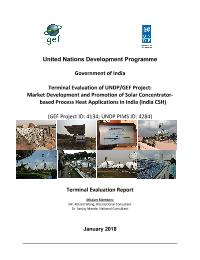
Terminal evaluation - Market Development and Promotion of Solar Concentrator based Process Heat Applications in India
Completedon 8 Dec, 2017
Evaluation Plan
Planned End Date
Jul 2017
Evaluation Type
Project
Management Response
Yes
Evaluation Budget
$20,000
Evaluation Title
Terminal evaluation - Market Development and Promotion of Solar Concentrator based Process Heat Applications in India
Atlas Project Number
00061446
Plan Period
Status
Completed
Type
Project
Plan Date
20 Jul, 2017
Completion Date
8 Dec, 2017
Budget
$20,000
Expenditure
$20,000
Source of Funding
Project
Management Response
Yes
Quality Assessment
Yes
Joint Programme
No
Joint Evaluation
No
GEF Evaluation
Yes
Expand
Stakeholders
Ministry of New and Renewable Energy (MNRE)
Countries
India
Atlas Project Number
00061446
Plan Period
Status
Completed
Type
Project
Management Response
Yes
Plan Date
20 Jul, 2017
Quality Assessment
Yes
Completion Date
8 Dec, 2017
Joint Programme
No
Joint Evaluation
No
Budget
$20,000
GEF Evaluation
Yes
Expand
Expenditure
$20,000
Stakeholders
Ministry of New and Renewable Energy (MNRE)
Source of Funding
Project
Countries
India
Output 1.5. Inclusive and sustainable solutions adopted to achieve increased energy efficiency and universal modern energy access (especially off-grid sources of renewable energy)
1: Environment & Sustainable Development
2: Others


